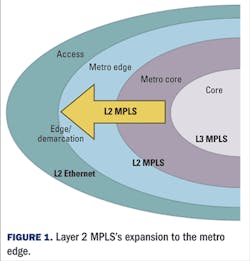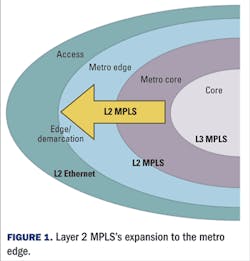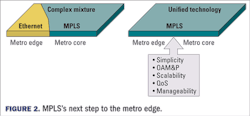By Eylon Sorek
Overview
The maturity of Carrier Ethernet and the adoption of MPLS in the metro lend economic and technical support for an MPLS evolution to the metro edge. New deployments are validating this trend.
The Carrier Ethernet market has reached the maturity phase. After significant growth over the past five years, and with global annual revenues of about $2 billion, telecommunication service providers worldwide deploy metro aggregation networks and use Ethernet-based switches and routers for the delivery of residential triple-play, enterprise Layer 2 and Layer 3 VPN, and mobile backhauling services.
In today’s networking architectures, MPLS is the de facto technology of choice for metro networks. While IP/MPLS provider (P) and provider edge (PE) routers dominate the core networks, and native Ethernet is widely populated across access networks, MPLS-based products—with their carrier-grade and connection-oriented capabilities—have become the best economic and technical fit for metro aggregation networks (see Fig. 1).
Traditional concerns about MPLS cost and complexity are becoming obsolete. Economy of scale due to the wide deployment brought the technology’s hardware and software to robustness and reasonable prices. Wide deployment and robust standardization have simplified network operation and enabled a multivendor environment that lowers the service provider’s risks.
Why MPLS
The success of MPLS derives from its ability to grow networks quickly, introduce new services, and reduce expenditures. Let’s look at these capabilities more closely.
Separation between control plane and forwarding plane (“Layer 2.5”). MPLS introduced the concept of forwarding Layer 2 packets using the Layer 3 control plane. From the data-plane perspective, forwarding Ethernet packets with label swapping is cost optimized and increases performance over the alternative of having longest-match IP lookups. And from the control-plane perspective, routing and signaling protocols exchange network topology information for topology detection, path selection, and traffic engineering.
Inherent connection-orientation and traffic engineering. MPLS was originally designed for service providers’ specific needs for connection-oriented behavior and traffic engineering. The MPLS service hierarchy—multiple services by pseudowires into label switched path (LSP)—is suitable for deterministic traffic flow while guaranteeing network resources along the route. LSPs enable service providers to fully control their networks and guarantee high quality of experience for premium services such as video and voice.
Service scalability and granularity. MPLS is a strong technology for carrying any type of protocol or service. This is useful for backbone, metro, and legacy networks. MPLS can support practically an unlimited number of services; the protocol’s 20-bit label space (unlike Ethernet VLAN space) provides the necessary scalability to accommodate today’s increasing number of subscribers and service requirements. Ethernet’s ability to carry low-rate 10/100-Mbps, high-rate 1/10-Gbps, and soon 40/100-Gbps traffic, gives it the flexibility to support any service.
Hard quality of service. MPLS enables hard quality of service (QoS) for a variety of bandwidth, delay, and protection requirements. MPLS’s rich set of QoS technologies include resource reservation mechanisms such as Connection Admission Control (CAC), as well as traffic management (TM) queuing and shaping mechanisms such as Differentiated Services (DiffServ).
Service high availability and resiliency. As an important part of “carrier-grade” capabilities, MPLS networks provide faster protection time than IP networks as well as scalable loop detection and prevention mechanisms. This is valuable for all types of connectivity services, including point-to-point, point-to-multipoint, and multipoint-to-multipoint. High availability and resiliency are mandatory requirements to ensure service-level agreements (SLAs) and differentiate basic versus premium services.
Service operation, administration, maintenance, and provisioning (OAM&P). The MPLS package includes a wide and reliable set of OAM&P tools. This enables multilayer support at physical, link, path, and service layers. A popular example is LSP ping/traceroute features that test connectivity.
Wide deployment promotes economy of scale. MPLS is widely deployed, and therefore MPLS-based hardware and software components have become robust and affordable. Common operation methodologies are used and VPWS/VPLS have become brand names for connectivity types and services description.
Well-defined standards and interoperability. The mature standardization of MPLS reduces cost and complexity both for equipment vendors and service providers. In addition, well-defined and -accepted standardization enables interoperability at all levels: product interoperability, services interoperability, and network interoperability.
MPLS at the metro edge
From the service provider’s perspective, an entire metro network based on a single technology is a desired goal. Simpler and more scalable service delivery can be achieved on a unified MPLS platform (see Fig. 2).
This opens the door for MPLS expansion to the smaller products that are located at the metro edge and act as the first level of metro aggregation. The table shows how the MPLS benefits of the high-end products can turn to competitive assets for the smaller products.
More and more service providers are recognizing the benefits of expanding their MPLS domain from the metro core to the metro edge. MetroNet, a Mexican carrier of carriers, is a real-life example of this approach. This service provider has announced its intention to stretch its MPLS networking infrastructure to the metro access to cope with significant traffic growth.
From the networking vendors’ perspective, offering competitive MPLS products to the metro edge is not an easy task. Reusing hardware and software from high-end platforms will yield an expensive offering, and trying to patch MPLS onto Ethernet switches will yield a non-standard and non-carrier-grade offering. Therefore, a new design is needed to provide the benefits of MPLS in an affordable product that should be deployed across a large number of locations.
More to come
Layer 2 MPLS brings clear value to the metro edge by offering a unified networking platform that combines all of the capabilities of MPLS with the benefits of a unified network, including simplicity, ease of operation, and cost-effectiveness. End-to-end MPLS, with a wide set of carrier-grade and connection-oriented capabilities, is increasing the scalability of services and enabling next-generation networking requirements.
This new opportunity for networking technology expansion has begun to be realized. Looking forward, one can foresee more announcements from service providers that are adopting Layer 2 MPLS at the metro edge, like MetroNet, as well as networking vendors that are shaping their products for this target.
Eylon Sorek is director, marketing, at Orckit-Corrigent (www.orckit.com).
Links to more information
LIGHTWAVE: ROADMs: Coming to the Edge of a Network Near You
LIGHTWAVE ONLINE: Infonetics: MPLS-TP Yes, PBB-TE Not So Much
LIGHTWAVE ONLINE: MetroNet Upgrades Infrastructure with Orckit-Corrigent Transport System



